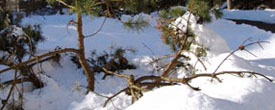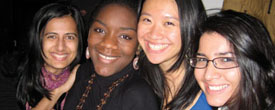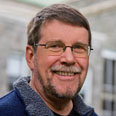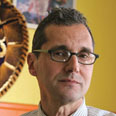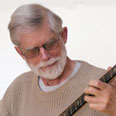Features
[Still] Need Blind in Tough Times
By Susan Clarey
![[Still] Need Blind in Tough Times](wp-content/uploads/2010/April/April_2010_homepage_pics/homepage_financial_aid.jpg) Sara Lipshutz ’11, a busy junior biology major, would not be at Swarthmore without a scholarship. Nor would John Boucard ’10, who plans to go to medical school after graduation. They are just two of the 760 students who are receiving need-based aid at the College this year—about half the student body.
Sara Lipshutz ’11, a busy junior biology major, would not be at Swarthmore without a scholarship. Nor would John Boucard ’10, who plans to go to medical school after graduation. They are just two of the 760 students who are receiving need-based aid at the College this year—about half the student body.Lipshutz, from New City, N.Y., has been funded since her freshman year with money from the College’s endowment. As a sophomore with a strong interest in the performing arts, she received a Margaret Hall Johnson Scholarship, which continues. This semester, she’s studying at the University of Cape Town, South Africa, in a Swarthmore-sponsored program called Globalization and the Environment. And every dollar of her financial aid went with her.
As a seventh-grader in Newark, N.J., Boucard was identified as gifted and placed in the New Jersey Seeds Program, which helps students gain acceptance into private high schools around the country. After graduating from the Church Farm School in Exton, Pa., he applied to Swarthmore and was awarded a McCabe Scholarship. He wants to become a pediatric surgeon.
Features
Velvet & Steel
By Elizabeth Redden ’05
Illustration by Edward Sorel
Photographs by Eleftherios Kostans
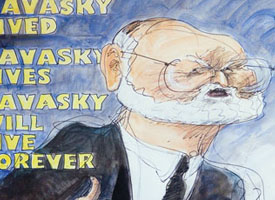 VICTOR NAVASKY ENJOYS A GOOD FIGHT: a boxing match, a debate, a gentlemanly duel, his preferred weapon a barbed article in a journal of opinion.
Navasky, the publisher emeritus and former editor of The Nation and now professor at Columbia University Graduate School of Journalism, is not pugnacious but temperate in demeanor. He is interested in controversy, but he is not a controversialist. He is at home in the public sphere, the realm of argument and counterargument. “He can be in the fray and stand above it at the same time,” says his close friend E.L. Doctorow, the novelist.
VICTOR NAVASKY ENJOYS A GOOD FIGHT: a boxing match, a debate, a gentlemanly duel, his preferred weapon a barbed article in a journal of opinion.
Navasky, the publisher emeritus and former editor of The Nation and now professor at Columbia University Graduate School of Journalism, is not pugnacious but temperate in demeanor. He is interested in controversy, but he is not a controversialist. He is at home in the public sphere, the realm of argument and counterargument. “He can be in the fray and stand above it at the same time,” says his close friend E.L. Doctorow, the novelist. Related Article
Features
The Essence of “S-ness”
By Carol Brévart-Demm
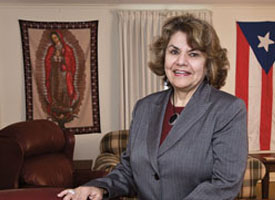 Who of us would ever have imagined that the letter s could be of any significance in issues of social status? For Ana Celia Zentella, the Eugene M. Lang Visiting Professor for Issues of Social Change, phenomena like the “s-ness” in pronunciation of Spanish language varieties offer important linguistic pointers on how speakers of those languages perceive themselves and others whose pronunciation differs from their own.
Who of us would ever have imagined that the letter s could be of any significance in issues of social status? For Ana Celia Zentella, the Eugene M. Lang Visiting Professor for Issues of Social Change, phenomena like the “s-ness” in pronunciation of Spanish language varieties offer important linguistic pointers on how speakers of those languages perceive themselves and others whose pronunciation differs from their own. Features
A Survey in Progress
By Jeffrey Lott
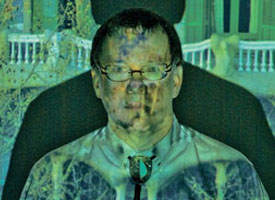 It used to be that, like a hot shower or a glass of orange juice, an art history survey course was best taken first thing in the morning. Anyone who ever took one knows this. As one of the few academic disciplines taught in the dark, with slide after slide flashing on the screen while whirring projectors pumped hot air into an already stuffy room, art history after lunch was often soporific. But in the morning, there was a cup of joe in your hand and a fighting chance to stay alert as you engraved image after image into your memory, scratching notes on paper you could barely see, connecting great works period-by-period, artist-by-artist into a sort of Aristotelian cosmology of painting, sculpture, and architecture that reached back through the Romans, Greeks, Sumerians, and Egyptians, all the way to the Paleolithic. (Who can forget the “Venus” of Willendorf?) And that was just the first semester.
It used to be that, like a hot shower or a glass of orange juice, an art history survey course was best taken first thing in the morning. Anyone who ever took one knows this. As one of the few academic disciplines taught in the dark, with slide after slide flashing on the screen while whirring projectors pumped hot air into an already stuffy room, art history after lunch was often soporific. But in the morning, there was a cup of joe in your hand and a fighting chance to stay alert as you engraved image after image into your memory, scratching notes on paper you could barely see, connecting great works period-by-period, artist-by-artist into a sort of Aristotelian cosmology of painting, sculpture, and architecture that reached back through the Romans, Greeks, Sumerians, and Egyptians, all the way to the Paleolithic. (Who can forget the “Venus” of Willendorf?) And that was just the first semester. Related Articles
Books + Arts
How College Classmates Helped Rebuild War-torn Europe
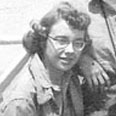 World War II had recently ended, and Maryal Stone (known also by the pen name Alzina Stone Dale) had her Swarthmore diploma in hand. Unsure of what her next step would be, the Chicago native volunteered to go overseas with the Quakers and help rebuild war-torn Europe. After four days of orientation at the American Friends Service Committee’s (AFSC) Pendle Hill Conference Center, Stone and four classmates—Amy Blatchford Hecht, Elspeth Monro Reagan, Jenny (Mary) Lee Suiter, and Nell Goldstein Stern—boarded the Arosa Kulm, a converted troop ship.
World War II had recently ended, and Maryal Stone (known also by the pen name Alzina Stone Dale) had her Swarthmore diploma in hand. Unsure of what her next step would be, the Chicago native volunteered to go overseas with the Quakers and help rebuild war-torn Europe. After four days of orientation at the American Friends Service Committee’s (AFSC) Pendle Hill Conference Center, Stone and four classmates—Amy Blatchford Hecht, Elspeth Monro Reagan, Jenny (Mary) Lee Suiter, and Nell Goldstein Stern—boarded the Arosa Kulm, a converted troop ship.
In My Life
Teeing Off
By Ted Hoey ’52
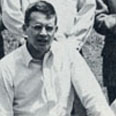 Turning the pages of the Bulletin as I always do, I suddenly see some young men and women looking just like young golfers. Yes, young tigers ready to go after par on any occasion. Swarthmore golfers. Amazing.
Turning the pages of the Bulletin as I always do, I suddenly see some young men and women looking just like young golfers. Yes, young tigers ready to go after par on any occasion. Swarthmore golfers. Amazing.I was a Swarthmore golfer. Back around 1950. Things sure have changed since then. For me it all started in my hometown of Chillicothe, Ohio. My father was a member of the local country club, and I was a caddy for several years.
